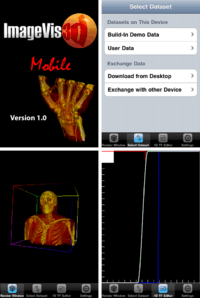ImageVis3D
 | |
|
A screenshot of ImageVis3D, demonstrating the ClearView [1] feature on the visible human male dataset. | |
| Developer(s) | Scientific Computing and Imaging Institute |
|---|---|
| Stable release |
3.1.0
/ April 8, 2014 |
| Written in | C++, OpenGL, DirectX |
| Operating system | Cross-platform |
| Type | Volume rendering |
| License | MIT |
| Website | http://www.ImageVis3D.com |
ImageVis3D is a lightweight, open source, volume rendering application for the interactive visualization of very large volumetric data sets. It utilizes both the slice based as well as the GPU ray casting approach to visualize the volume data. The source code is currently maintained in a publicly accessible Subversion repository [2] by the Scientific Computing and Imaging Institute [3] at the University of Utah.
History
ImageVis3D's development was initiated in 2007 by the NIH/NCRR Center for Integrative Biomedical Computing and additionally supported by the DOE Visualization and Analytics Center for Enabling Technologies at the SCI Institute. After an initial development phase of about one year the project was released under the MIT license and since then multiple institutions from America, Europe and Asia are contributing to the software. Recently the first version of ImageVis3D mobile has been released, allowing for the mobile visualization of volumetric scalar data.
Features
- has a rich feature set for volume rendering Cartesian scalar and color data
- supports 1D and 2D transfer functions as well as isosurface extraction and the ClearView rendering technique
- supports stereo rendering
- takes full advantage of the features of the newest generation of graphics cards but still works well on older hardware
- supports the most common industry and research file formats including DICOM stacks
- works entirely out of core, making it possible to interactively visualize hundreds of gigabytes of data on commodity hardware
- connects to ImageVis3D Mobile, an iPhone/iPod touch application, to allow for interactive volume rendering anywhere
- is divided into multiple modules (e.g. UI, IO, rendering) which can all be used separately. Examples of such separate use are the integration of parts ImageVis3D into other open source and commercial products (see list below)
- is released under the MIT license
 The full color visible human male dataset rendered with ImageVis3D. |
 An anaglyph image of a human body rendered with ImageVis3D. |
 An anaglyph image of a human body rendered with ImageVis3D. |
 ImageVis3D rendering the engine volume data set in different modes. |

ImageVis3D in other applications
ImageVis3D or more precisely its volume rendering core has been incorporated into other applications such as VisIt and VisTrails [4]
Sample Datasets
Some sample datasets are now available from the ImageVis3D download page.
See also
References
- ↑ "The ClearView volume rendering method".
- ↑ "ImageVis3D webpage".
- ↑ "SCI webpage".
- ↑ "VisTrails website".
